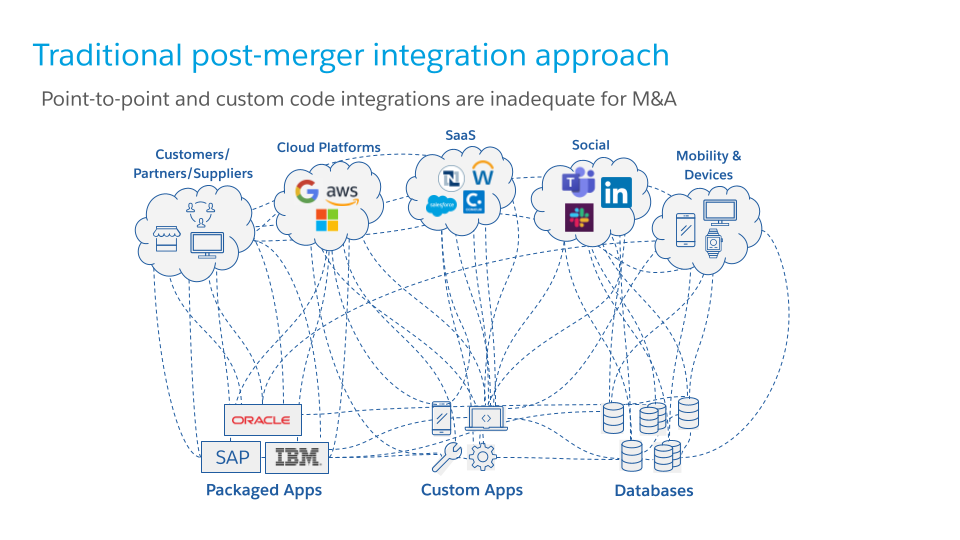How an integration strategy can drive business outcomes
Integrations and APIs are considered to be the digital bedrock of organizations. To shed light on integration strategy needs, we attempt to simplify how stakeholders and executives without deep technology expertise can evaluate their respective integration strategies and related investments.
We start with one fundamental question: “Does the organization have an integration strategy?”
If the answer is no, it’s important to understand how an API program helps businesses achieve digital transformation in the modern age. But if the answer is yes, this strategy can be evaluated through three lenses.
The three value lenses
Once an organization has started defining its API strategy, the first thing it needs to do is determine the value it hopes to deliver. When measuring value, it can be tempting to look through one of two lenses: the TCO lens or the Productivity lens.
Lens 1: The total cost of ownership (TCO) lens
Is the integration strategy achievable at the lowest cost relative to returns it delivers to the business?
The total cost of ownership (TCO), or total cost of integration (TCI) lens is calculated by adding up the costs of three line items in an organization’s technology budget:
- Hardware (virtual, on-premise, hybrid, or cloud) supporting the implemented integration technologies
- Software enabling the integration strategy (including, but not limited to API development, management, orchestration, administration, and gateway and monitoring software)
- People costs: internal, external, and contingent labor needed to deliver on the organization’s integration strategy
Lens 2: The productivity lens
Does the integration strategy and associated platform enable greater productivity across the IT organization?
The productivity lens is focused exclusively on the integration and API producers and administrators and measuring their level of productivity without consideration for potential positive downstream productivity impacts for their integration and API consumers.
Productivity is ultimately quantified at a single integration unit level:
- Time to develop new integrations or APIs
- Time to maintain new integrations or APIs
- Time secure new integrations or APIs
- Time to test and QA (UAT, SIT) new integrations or APIs
- Time and effort to administer, maintain, upgrade, and manage the integration environment
Lens 3: The business outcomes lens
What results will this strategy deliver to the broader organization?
There is a third lens that will likely drive more strategic value than the other two combined: the business outcomes lens. This lens is focused on everything else. The simplest way to think about the impact an integration strategy can have on an organization is by asking what we wouldn’t be able to do without integrations or APIs.
Given the average organization manages 50 applications at a minimum, has multiple distribution channels and a variety of customer or client segments, the short answer is a lot. The question then shifts to one of attribution, e.g. how much does an optimized integration strategy contribute to that ill-defined “a lot”? A more practical question is “how much better or how much faster can the company achieve certain outcomes by deploying one integration strategy relative to the next best alternative?”
To simplify measurement, organizations can further evaluate the impact of integration by examining what these different applications power and enable outside of the realm of IT efficiency. Some useful categories of impact include:
- Time-to-market of revenue generating external products, measured by calculating potential interest to be earned on accelerating time-to-market, thereby increasing time-in-market by X number of months or years
- Contribution to improved productivity of corporate function, business unit, or revenue generating teams (e.g. elimination of shadow IT; can be measured based on findings from time-and-motion studies)
- Contribution to risk mitigation of future possible hazards or events
3 examples of how MuleSoft’s Business Value Services team has helped customers
To elaborate on the above, we’ve compiled three examples of how MuleSoft’s Business Value Services team has helped customers evaluate their respective integration strategies and measure potential impacts of refining these strategies on their desired business outcomes.
1. Pharmaceutical customer
We engaged with a pharmaceutical customer seeking to drive better data currency for its commercial marketing and sales teams by increasing the frequency of its sales reporting. Given rapidly changing sentiment for certain products in the market, data currency was a critical driver of market relevance and revenue capture. We partnered with product, marketing, and tech executive stakeholders to assess the potential market opportunity improved data currency could provide to sales executives.
According to the American Health Information Management Association (AHIMA) data currency can be defined as: the extent to which data are up-to-date; a datum value is up-to-date if it is current for a specific point in time, and it is outdated if it was current at a preceding time but incorrect at a later time
Benefits illustrated below are driven by a 334% uplift in commercial data currency (units in $M).

Assumptions:
Acceleration of data time to market benefits:
Current State
Assumptions:
- Monthly reporting; with average data age of >15 days
- FY21 forecasted revenues = $42B
- Data Currency = 3.3% = 12/365
- Batch report process runs for min 8 hrs
- Average data age = 15.2 days
- Value of current state data = $1.4B
- Japan region represents $1B/annual revenue; 1% * $1.0B = $10.0M
Future state:
- Weekly reporting
- Data currency = 14.3%
- Batch report process runs for max 4 hrs
- Average data age = 3.5 days
- Value of future state data = $4.3B
- 1% of data impacts revenue-making decisions = 1% * $4.3B = $43.4M
- Delta = $43.4M – $10.0M = ~$33M
2. Finserv customer, banking
We engaged with a banking customer seeking to drive accelerated commercial loan growth. In partnership with key executives, we measured the potential market-facing impact of improved integration.
Within the loan division, the key metrics for this customer were relationship manager (RM) productivity, RM to underwriter ratio, incremental loan volumes, and net interest margin (NIM).
Through interviews with various stakeholders across the business and technology teams, the customer asserted that the paper-intensive loan review, underwriting and onboarding process was causing significant inefficiencies among the RMs, requiring upwards of 25% of relationship managers’ time.
Through API-enabled automation of loan processing and onboarding, we estimated a conservative impact of a 1% efficiency gain in year one with an intentional API strategy, 2% efficiency in year two, on a ramp to a steady state of 3% incremental efficiency by year three. Using the current book of business as a baseline, over a three-year period, this efficiency gain translated into an increase in loan volumes of 112, which translated to $78M in loan outstandings and $2.7M NIM gain based on the bank’s cost of capital.
Though these results may not seem compelling, the conservative projection assumed that the company could only improve its producer efficiency by 3% over three years or fewer than one eighth of its potential.

Expected Impacts:
Relationship manager productivity increase (three year ramp to full productivity):
- Year 1 increase : 1%
- Year 2 increase: 2%
- Year 3 increase: 3%
- Year 4 increase: – N/A
- Year 5 increase: – N/A
Implied loan volume increase (average loan size = $701K)*
Ramp to 3% efficiency increase over three years:
- Year 1: 500 * 1.01 = 505 → 5
- Year 2: 505 * 1.02 = 515 → 10
- Year 3: 515 * 1.03 = 531 → 16
- Year 4: 531
- Year 5: 531
Delta over five years = 112 incremental loans; $78M outstandings; $2.7M NIM
Relationship manager to Underwriter ratio:
- Year 1: 1:1; 37:37
- Year 2: 1.1:1; 42:38
- Year 3: 1.2:1; 47:39
- Year 4: 1.25+:1
- Year 5: 1.25+:1
3. Early-stage SaaS digital publishing company
We engaged with an early-stage SaaS digital publishing company seeking to drive scale and growth of its platform in the North America market. In partnership with key product and technology executives, we measured the market-facing impact that improved integration could have on one key metric that drove multiple critical outcomes: development speed and capacity.
The faster and more efficient the product team could be, the faster the company could scale, bring on new customers and begin recognizing revenue from its SaaS solution.



Assumptions:
Current State:
- Six to eight concurrent customer ingestions in year one
- Six to nine month customer ingestion duration (projected acceleration timeline below)
- $1M ACV revenue per customer; four-year subscription cycle
- 45 to 50 professional services developers
Acceleration expected based on intentional API development strategy designed to optimize re-use of API assets over time:
Development speed and capacity:
- Year 1 increase: 5%
- Year 2 increase: 20%
- Year 3 increase: 33%
- Year 4 increase: 35%
- Year 5 increase: 40%
Customer ingestion duration (acceleration driven by professional services’ team traversing integration platform learning curve):
- Year 1: Eight months
- Year 2: Seven months
- Year 3 and onward: Six months
Concurrent customer ingestion (increased capacity for concurrency driven by professional services’ efficiencies):
Year 1: Six to eight
Year 2: Eight to 16
Year 3: 16 to 20
Year 4: 24 to 30
Want to know more? Reach out to the Business Value Services team to learn how you can evaluate your company’s integration strategy and align that strategy to organizational objectives and outcomes.









